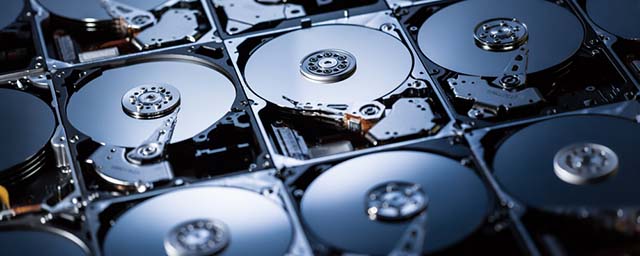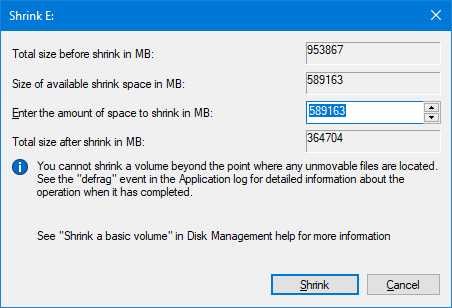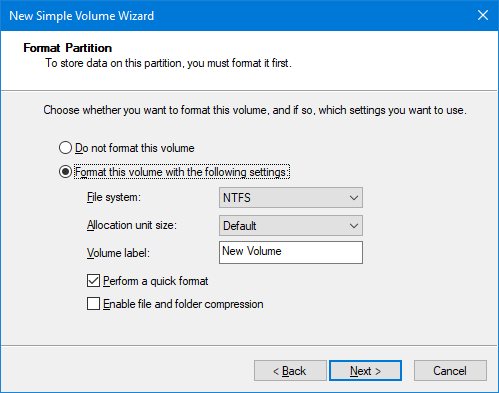Partition to create the second hard drive on Windows
If you want to split the hard drive into different parts, you can use partitions to do that. With Disk Management - a default Windows tool, we will introduce you to all terms and instructions on how to resize, delete and create partitions. Basically, this is a virtual process to add additional hard drives.
- Instructions for dividing hard drives right in Windows 10
- Instructions to divide and merge drives right in Windows 7
- Restore deleted drive partitions with Active Partition Recovery
What is partitioning?
Storage is a physical component. It may be on your system or be connected to a computer from outside. Storage drives have a specific capacity limit, if you have no space to store, you need to delete data or buy a new hard drive.

We will look at how to partition the hard drive. Partitioning is a block of space on the drive that Windows manages separately. A single drive can consist of one or more partitions and each drive carries its own drive letter, except for the hidden partition that we will mention later.
Using partitions will bring a lot of benefits. The best known benefit is that it helps to divide the operating system from user files. That is, you can reinstall the operating system without losing data, and create backups for each individual file. It can also help you protect files. If one of the partitions is broken, that doesn't mean that the remaining partitions will be the same.
Learn about Disk Management
Windows has a built-in tool called Disk Management, which helps you create, delete and manage partitions on your hard drive. To start, press Windows + R key to open Run, enter diskmgmt.msc and click OK. This will open Disk Management.

The top part of the window shows you the existing partitions that Windows calls Volume. The bottom part represents the data visually. Each physical drive has rows and individual partitions are displayed as separate blocks.
For example, in the image above, you can see Disk 0 has a capacity of 931.39 GB (which is a 1 TB hard drive but because of the way the storage is active, you will not be able to use the full capacity of the drive).
The three partitions on the drive shown above are:
- EFI System Partition: This is one of the previously mentioned partitions without a drive letter, but it is very important. This drive contains the files needed to start Windows and the files are not deleted.
- Page File, Primary Partition: This is the primary partition on the drive - where most files are stored.
- Recovery Partition: This partition will help you recover the system if the primary partition is corrupted. The drive also has no drive letter and is hidden.
Use Disk Management
Quite simple to use Disk Management, but it is important that you know each of its features in order not to accidentally delete data. If you are interested, consider creating a drive backup before continuing.
Resize a partition
Before creating a new partition, first, you need to create some free space by resizing the existing Volume. To do this, right-click a partition and select Shrink Volume . You can only use this option if you have free space on your hard drive.

Enter a value in the section Enter the amount of space to shrink in MB . For example, if I want to shrink a 100 GB partition to 50 GB, I will enter 50000 (there are about 1000 MBs in a GB). Then click Shrink .
If you want to increase the current partition size, right-click on the partition and select Extend. Here, you need to enter the size you want to increase.
Delete a partition
You can free up space by deleting an existing partition. However, you need to be careful because this operation will erase all data on your partition. Remember to back up important data before continuing or they will disappear forever.
You can refer to how to delete this partition: How to delete a partition on Windows hard drive?
Create a partition
There is a black block representing the free space in the drive. Right-click on the icon and select N ew Simple Volume . A window will open and guide you through the process of creating the partition. Click Next. In Simple volume size in MB , enter the capacity value you want to create for the partition. Remember that 1000 MB equals 1 GB.
Click Next. Here, you can assign a drive letter or path. Select the option Assign the following drive letter , but you can also use the drop-down menu to select a different character. Click Next.

On this screen, you can choose to format the partition. You can freely change the volume name with the Volume label field. If you want to change nothing, leave everything as default, then click Next.
The final screen will summarize all your options. Click the Back button if you want to change anything, otherwise, click Finish to create your partition.
Conclude
Now that you know how to use the Data Management tool, you can control your hard drive as an expert. Remember, be aware before changing or editing existing partitions. No matter what happens if you follow the advice above.
What purpose do you use disk partitions for? Do you have any advice on using Disk Management? Let us know by commenting below!
You should read it
- 2 ways to hide hard disk partitions on Windows
- Disk Management access in Windows 7 and Windows 8
- How to delete a drive cannot be deleted with Disk Management
- How to split and partition hard drive with EaseUS Partition Master software
- How to Delete a Drive Partition on PC or Mac
- (Giveaway) Copyright free EaseUS Partition Master Professional Edition Best hard drive management software
- Dissection of hard drive components
- How to transfer free space from one drive to another in Windows 10
May be interested
- Instructions to divide and merge drives right in Windows 7
 if in windows xp, when you want to split or merge disk partitions on a hard drive, we can't directly manipulate windows but need to use external software (pq magic, arconis, paragon ...). as for windows 7, this is easy because that feature has been improved ...
if in windows xp, when you want to split or merge disk partitions on a hard drive, we can't directly manipulate windows but need to use external software (pq magic, arconis, paragon ...). as for windows 7, this is easy because that feature has been improved ... - How to partition hard drive without losing data on Windows 10, 11 simply
 repartitioning your hard drive is an important operation when you need to manage your storage space more effectively. how to partition your hard drive effectively without affecting data or avoiding file loss
repartitioning your hard drive is an important operation when you need to manage your storage space more effectively. how to partition your hard drive effectively without affecting data or avoiding file loss - How to Partition a Hard Drive in Windows 8
 partitioning divides a hard drive into two or more smaller, separate drives. the larger a drive is, the longer it can take for the computer to retrieve data on that drive. partitioning a large drive can speed up the drive access time....
partitioning divides a hard drive into two or more smaller, separate drives. the larger a drive is, the longer it can take for the computer to retrieve data on that drive. partitioning a large drive can speed up the drive access time.... - This is how to delete Recovery partition and Recovery partition 450 MB on Windows 10
 recovery partition (recovery partition) is a separate partition on the hard drive on your computer or ssd and used to restore or reinstall the operating system in case the system fails.
recovery partition (recovery partition) is a separate partition on the hard drive on your computer or ssd and used to restore or reinstall the operating system in case the system fails. - Fix errors can not merge hard drives, partitions on Windows
 although the process of merging hard drives and partitions on windows 10 is extremely simple, you have done many times without success, causing you to question why is it so.
although the process of merging hard drives and partitions on windows 10 is extremely simple, you have done many times without success, causing you to question why is it so. - 2 ways to hide hard disk partitions on Windows
 in the process of using computers, we often have to store a lot of important data in a fixed hard disk partition. to avoid accidentally deleting important data in it, you should have a protection plan by hiding the partition. if you do not know how to do it, you can refer to how to do below of tipsmake.com.
in the process of using computers, we often have to store a lot of important data in a fixed hard disk partition. to avoid accidentally deleting important data in it, you should have a protection plan by hiding the partition. if you do not know how to do it, you can refer to how to do below of tipsmake.com. - 4 ways to quickly check the partition type on Windows 11
 when setting up a new hard drive, it is essential to verify that it is using the correct partition type. partition type plays an important role in the management and formatting of the drive and affects compatibility with various system features and programs.
when setting up a new hard drive, it is essential to verify that it is using the correct partition type. partition type plays an important role in the management and formatting of the drive and affects compatibility with various system features and programs. - How to install Windows 10 from internal hard drive partition
 here's how to install windows 10 from the internal hard drive partition, as well as how to create a new partition, get it working and bootable.
here's how to install windows 10 from the internal hard drive partition, as well as how to create a new partition, get it working and bootable. - How to split and partition hard drive with EaseUS Partition Master software
 how to split and partition hard drive with easeus partition master software. as you know, we often divide hard drives into different partitions to make it easier to manage our data. to split the drive we can use the available disk management feature t
how to split and partition hard drive with easeus partition master software. as you know, we often divide hard drives into different partitions to make it easier to manage our data. to split the drive we can use the available disk management feature t - Instructions for Partitioning Hard Drives with Partition Wizard 100% Successful
 hoang ha pc will guide you how to successfully partition your hard drive using partition wizard. let's learn how to use partition wizard in the article below!
hoang ha pc will guide you how to successfully partition your hard drive using partition wizard. let's learn how to use partition wizard in the article below!










 Samsung revealed the biggest screen you can buy today
Samsung revealed the biggest screen you can buy today Do you know how much RAM a smartphone needs to use?
Do you know how much RAM a smartphone needs to use? Ranked 25 fastest gaming laptops
Ranked 25 fastest gaming laptops How to manually turn off the power light and hard drive light on the desktop
How to manually turn off the power light and hard drive light on the desktop How to check the application using Webcam using Process Explorer
How to check the application using Webcam using Process Explorer How to fix typed keyboard errors when entering content
How to fix typed keyboard errors when entering content